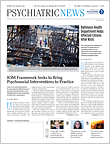Quality measures for inpatient psychiatric treatment must balance the need for information about quality of care with the imperative to minimize the burden of data collection and reporting by physicians.
That’s what APA CEO and Medical Director Saul Levin, M.D., M.P.A., told the Centers for Medicare and Medicaid Services (CMS) in comments responding to a proposed rule by CMS governing payment for psychiatric inpatient treatment.
The April 24, 2015, proposed rule updated the estimated payments to Inpatient Psychiatric Facilities in FY 2016 relative to estimated payments in FY 2015 by 1.6 percent (or $80 million). But the rule also proposed updates to the Inpatient Psychiatric Facility Quality Reporting (IPFQR) Program, expanding the measure sets in future fiscal years and changing certain data-reporting requirements for these measures. (The IPFQR requires participating facilities to report on quality measures or incur a reduction in their annual payment update.)
Levin, in a June 23, 2015, letter to CMS Acting Administrator Andrew M. Slavitt, concentrated his comments on the quality measures—supporting some changes and urging reconsideration of others. He drew attention to the problems associated with the use of electronic health records (EHRs) to report quality measures across different health care systems.
“[M]any of the psychiatric facilities under the IPF PPS [prospective payment system] are not stand-alone psychiatric hospital systems, and this presents a problem for those psychiatric units within a larger system,” Levin wrote. “Larger systems may not develop EHR programs that include the measures necessary for reporting in the IPFQR or, if the system does include the psych specific measures, it can complicate reporting in other programs for physicians in other specialties. For example, either a measure is not included in the EHR at all and then the psychiatric clinicians are unable to report on them, or the expectation is that an obstetrician use the same interface a psychiatrist would use and then become responsible for reporting on psychiatric measures. This represents a significant problem for physicians who are not in stand-alone psychiatric facilities—and APA urges CMS to consider the needs of all those who are reporting in the IPFQR as the program continues to grow.”
Levin offered comments on quality measures in five specific areas: patients discharged on multiple antipsychotic medications, substance abuse screening and interventions, tobacco use treatment offered or provided at discharge, postdischarge continuing care, and screening for metabolic disorders.
He voiced support for the proposed addition of two measures (TOB-3 Tobacco Use Treatment Provided or Offered at Discharge and TOB-3a Tobacco Use Treatment at Discharge) designed to assess whether physicians are offering or providing tobacco use treatment to patients discharged from inpatient psychiatric facilities. He also welcomed the removal of a quality measure (HBIPS-4: Patients Discharged on Multiple Antipsychotic Medications) requiring documentation of care for patients discharged on multiple antipsychotics.
Levin said a preexisting measure (HBIPS-5: Patients Discharged on Multiple Antipsychotic Medications With Appropriate Justification) already appropriately measures the quality of care for those receiving multiple antipsychotics.
Levin also supported the inclusion of a quality measure addressing metabolic disorders in patients treated in inpatient psychiatric facilities, but requested that CMS make the full specifications of the measure public.
“People with serious mental illness die at a very high rate from cardiovascular illness, whether they are on a second-generation antipsychotic or not,” Levin wrote. “We concur that individuals with mental illness should be screened for metabolic disorders and have their medical issues more closely managed within psychiatric facilities. However, APA needs to further examine the specifications of the proposed measure before we can officially support … [its] addition to the program. We ask that CMS publish the full measure specifications for stakeholder feedback.”
Levin also supported the proposed addition of a measure addressing alcohol screening and intervention. But he said a second proposed measure (SUB-2 and 2A: Alcohol Use Brief Intervention Provided or Offered Alcohol Use Brief Intervention) was not appropriate for an inpatient setting.
“These [brief intervention] measures have been shown to have a modest effect in primary care and emergency room settings because the patient may not know [he or she has] an alcohol problem, and in those settings, providers often do not assess or discuss the problem,” Levin wrote. “But inpatient psychiatry is very different. If a psychiatric inpatient has an alcohol problem, [he or she] will likely need real treatment for alcohol—medication, counseling, etc. [Patients are] not receiving the care they need if they are simply given a brief intervention in a psychiatric setting, and APA does not believe these measures should be added to the IPFQR.”
Finally, Levin voiced concern about CMS’s proposed replacement of measures around postdischarge continuing care with new measures that do not account for the special circumstances of psychiatric inpatients and of inpatient psychiatric facilities. He said the existing measures (HBIPS-6: Post-Discharge Continuing Care Plan Created and HBIPS-7: Post-Discharge Continuing Care Plan Transmitted to Next Level of Care Provider Upon Discharge) “were developed with significant input from the psychiatric field and fully tested for validity and reliability in the psychiatric setting by both CMS and the Joint Commission.”
He added, “APA has serious concerns that these [newly proposed] measures may not be appropriate for the IPFQR and, given that there are already measures in place, we strongly urge CMS to refrain from replacing HBIPS-6 and HBIPS-7 with these measures until there is more clarity surrounding [their use] in a psychiatric setting.” ■
APA’s response to the proposed rule can be accessed
here.
